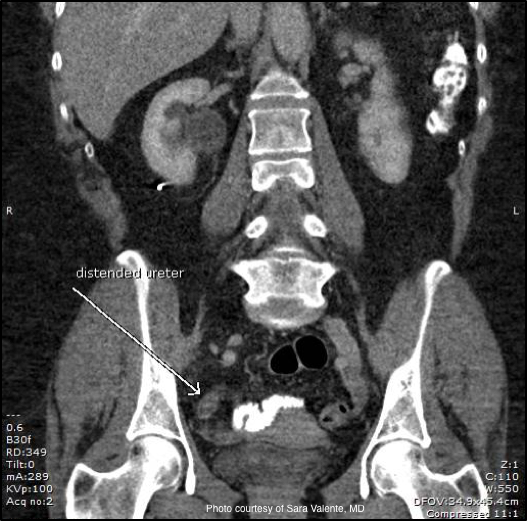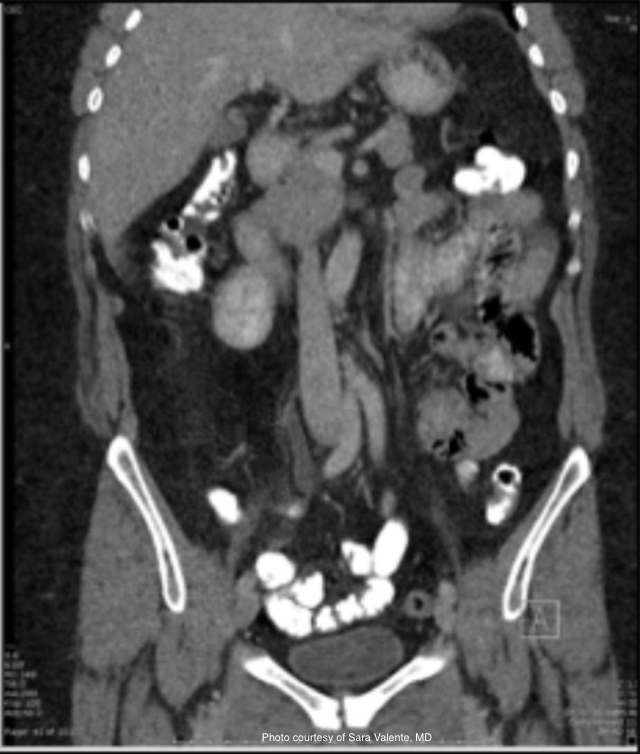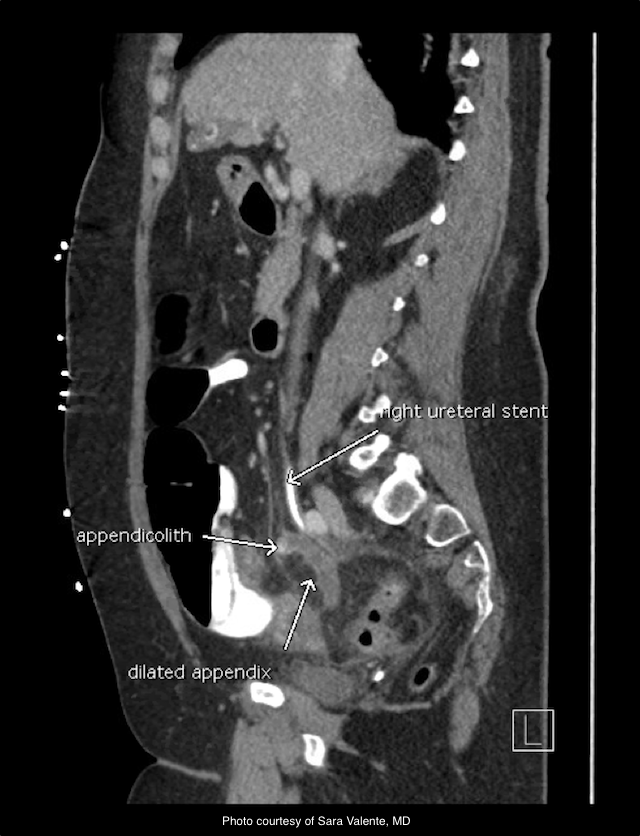Article
Challenging cases in urology: A case of hydronephrosis, sepsis, and pain
Author(s):
A 61-year-old female complains of acute-onset right-sided flank and abdominal pain. She describes associated nausea, but denied urinary symptoms, hematuria, fever, or chills.
Sara Valente, MD, is a fourth-year urology resident at the University of Connecticut School of Medicine, Farmington.

“Challenging Cases in Urology” is a new Urology Times section in which residents from the nation’s leading urology programs present their toughest cases and how they ultimately managed them. Cases inform readers of the problem-solving process and provide a lesson from the authors’ experience.
History
A 61-year-old female presented to the emergency department with a complaint of acute-onset right-sided flank and abdominal pain that awoke her from sleep. She described associated nausea, but denied urinary symptoms, hematuria, fever, or chills. One month ago she had been treated for a presumed urinary tract infection after presenting with dysuria and urinary frequency. She also reported intermittent abdominal pain dating back approximately 2 months.
Her past medical and surgical history was notable for a right-sided UPJ repair in 1978 as well as a history of nephrolithiasis and right-sided ESWL. She did not know the stone composition. Additional surgical history included only a previous tonsillectomy.
Examination
Evaluation in the emergency department revealed a leukocytosis of 16.7 thou/µL, a normal serum creatinine, and a clean catch urinalysis with 1 WBC/HPF, 4 RBC/HPF, nitrite positive, and leukocyte esterase negative. Complete metabolic panel and liver function tests were all within normal limits. A CT scan demonstrated moderate right-sided hydronephrosis, symmetric nephrograms, and a small calcification that appeared to be within the distal right ureter (figures 1 and 2).

Figure 1. Initial CT scan revealed moderate right hydronephrosis.

Figure 2. Right hydroureteronephrosis and small calcification near the right iliac artery.
Based upon these findings, the patient was taken to the operating room for stent placement. Cystoscopic evaluation of the bladder revealed no pathology. A right retrograde pyelogram showed a normal distal ureter with moderate hydronephrosis proximally, but no filling defect suggestive of a stone. A right ureteral stent was placed without difficulty. The patient remained afebrile and was discharged home.
The following day, the patient called and complained of persistent abdominal pain, nausea, urinary frequency, and urgency. She was encouraged to return to the emergency department where she was found to be afebrile, hemodynamically stable, but clearly uncomfortable. Her examination was significant for generalized abdominal pain and right CVA tenderness.
Repeat lab work
Repeat lab work revealed a leukocytosis that was now 17.5 thou/µL. Given this finding and her persistent intermittent abdominal pain, a repeat CT scan was ordered. This showed the right ureteral stent in good position, improved hydronephrosis, and a markedly dilated appendix with surrounding stranding consistent with acute appendicitis (figures 3 and 4).
The patient was seen by general surgery and ultimately taken to the operating room for laparoscopic appendectomy. Intraoperatively, she was found to have a large, inflamed appendix with a perforation at the base and purulent ascites (figure 5). Her final urine culture was negative.
One month after the initial stent placement, the patient was re-evaluated. She was asymptomatic and KUB revealed no ureteral calcification. The stent was removed without issue.

Figure 3. Repeat CT scan showed a well-positioned ureteral stent, no hydronephrosis, dilated appendix and an appendicolith.

Figure 4. Repeat CT shows right ureteral stent marking the true position of the right ureter.

Figure 5. Intraoperative image revealing a perforation at the base of the appendix and purulent ascites.
Discussion
Kidney stones affect millions of Americans and the prevalence is increasing. Recent literature suggests that the prevalence of stones in the U.S. is 8.8%, with a higher incidence in obese and diabetic patients (Eur Urol 2012; 62:160-5). In the setting of sepsis and ureteral obstruction, urgent decompression is mandatory (J Urol 2013; 189:946-51).
The traditional imaging gold standard to assess for nephrolithiasis is a non-contrast CT scan of the abdomen and pelvis. Verification of an obstructing stone generally requires a dilated ureter leading to an obstructing hyperdense calcification. Confirmation that the calcification lies within the ureter is rarely performed since contrast material would obscure the location of the stone. As a stent is placed care should be taken to visualize the stone, but a small stone can often be missed.
In this particular case, although the patient did have hydroureteronephrosis, the dilated structure containing a calcification turned out to be the dilated appendix. In hindsight, the patient’s right-sided hydronephrosis extended from the mid-ureter at the expected level of the appendix up to the kidney. We believe that the hydronephrosis was secondary to local inflammation from the patient’s underlying perforated appendicitis. As a consequence, while the ureteral stent resolved the patient’s hydronephrosis, it did not address the underlying pathology.
Reassessing the patient was the correct decision. A follow-up CT was warranted for several reasons. First, the patient’s leukocytosis had worsened, suggesting that whatever abscess was present was inadequately drained. Second, a close review of the initial CT shows prompt symmetric pyelograms suggesting minimal obstruction on the right side, which is inconsistent with the working diagnosis of an obstructing ureteral stone. A follow-up CT identified the true diagnosis of acute appendicitis with an accompanying appendicolith masquerading as a ureteral stone.
Conclusion
While flank or abdominal pain associated with hydronephrosis on imaging in conjunction with signs of sepsis should trigger concern for an obstructing calculus, other pathology can present with similar signs and symptoms. Clinicians must keep a critical and discerning eye and an open mind to ensure an accurate diagnosis.
Newsletter
Stay current with the latest urology news and practice-changing insights — sign up now for the essential updates every urologist needs.
















